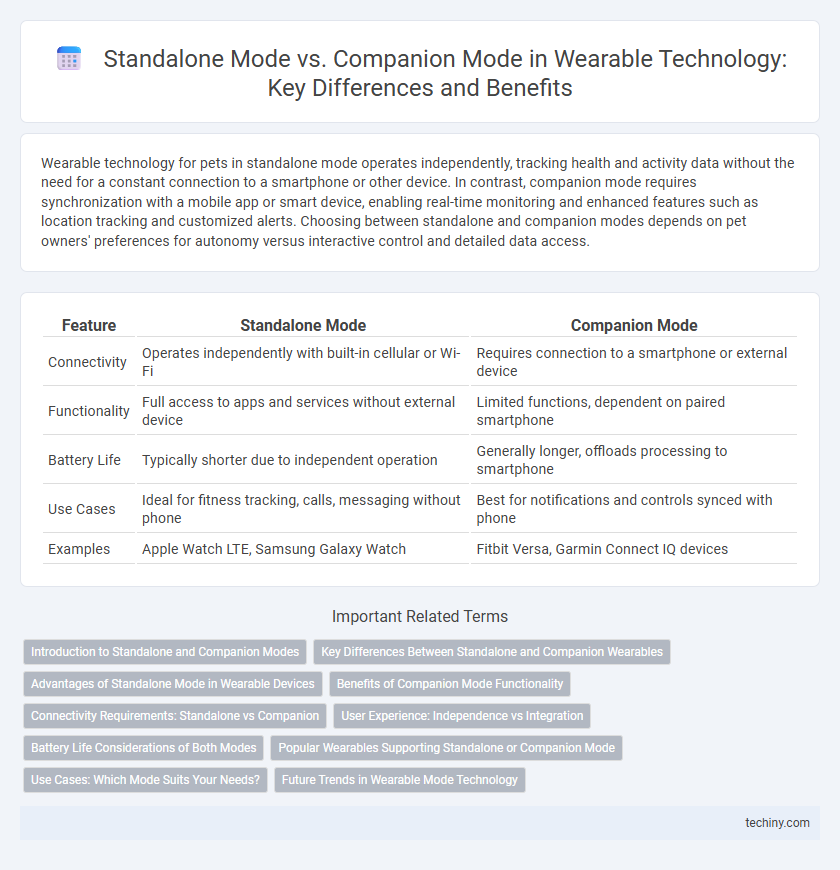Wearable technology for pets in standalone mode operates independently, tracking health and activity data without the need for a constant connection to a smartphone or other device. In contrast, companion mode requires synchronization with a mobile app or smart device, enabling real-time monitoring and enhanced features such as location tracking and customized alerts. Choosing between standalone and companion modes depends on pet owners' preferences for autonomy versus interactive control and detailed data access.
Table of Comparison
| Feature | Standalone Mode | Companion Mode |
|---|---|---|
| Connectivity | Operates independently with built-in cellular or Wi-Fi | Requires connection to a smartphone or external device |
| Functionality | Full access to apps and services without external device | Limited functions, dependent on paired smartphone |
| Battery Life | Typically shorter due to independent operation | Generally longer, offloads processing to smartphone |
| Use Cases | Ideal for fitness tracking, calls, messaging without phone | Best for notifications and controls synced with phone |
| Examples | Apple Watch LTE, Samsung Galaxy Watch | Fitbit Versa, Garmin Connect IQ devices |
Introduction to Standalone and Companion Modes
Standalone mode in wearable technology allows devices to operate independently by processing data and connecting to the internet without relying on a smartphone. Companion mode requires a paired smartphone to handle functions like data synchronization, app management, and communication, thus offloading processing tasks. Understanding these modes helps users choose wearables based on desired autonomy, connectivity, and battery life.
Key Differences Between Standalone and Companion Wearables
Standalone wearables operate independently with built-in cellular connectivity, processing power, and storage, enabling users to perform functions without a smartphone. Companion wearables depend on a paired smartphone for data processing, internet access, and enhanced functionalities, often requiring Bluetooth connections. Key differences include autonomy in connectivity, battery life implications, and functionality scope, with standalone devices offering greater independence and companion devices relying on smartphone integration.
Advantages of Standalone Mode in Wearable Devices
Standalone mode in wearable technology offers enhanced user independence by enabling devices to operate without reliance on smartphones, ensuring continuous functionality even in remote or signal-limited environments. These wearables typically incorporate built-in cellular connectivity, GPS, and processing power, which facilitate real-time health monitoring, navigation, and communication directly from the device. The autonomy provided by standalone mode significantly improves convenience and reliability, making it ideal for fitness tracking, emergency situations, and on-the-go lifestyle applications.
Benefits of Companion Mode Functionality
Companion mode in wearable technology enables seamless synchronization with smartphones, allowing users to access notifications, calls, and apps while conserving the wearable's battery life. It enhances performance by offloading complex tasks to the connected device, ensuring faster processing and extended device functionality. This mode also provides richer data integration, offering users comprehensive health and activity tracking through combined device ecosystems.
Connectivity Requirements: Standalone vs Companion
Standalone wearable devices operate independently by directly connecting to cellular networks via LTE or 5G, ensuring continuous internet access without the need for a smartphone, ideal for activities requiring mobility and untethered use. Companion mode wearables rely on Bluetooth or Wi-Fi connections to pair with a smartphone, leveraging its cellular data for online functionality, which limits connectivity to the phone's range and battery life. Understanding these connectivity differences is crucial for choosing between the convenience of total independence in standalone mode and the extended functionality but dependency in companion mode.
User Experience: Independence vs Integration
Standalone mode in wearable technology offers users complete independence, allowing devices to operate without requiring constant connection to a smartphone, enhancing convenience and mobility. In contrast, companion mode emphasizes seamless integration with a paired smartphone, providing enriched functionality through synchronized apps, notifications, and data sharing. This trade-off influences user experience by balancing autonomous operation with the benefits of connected ecosystems, catering to diverse preferences for freedom or comprehensive device interaction.
Battery Life Considerations of Both Modes
Standalone mode in wearable technology typically consumes more battery power as devices operate independently, managing all functions such as GPS, data processing, and connectivity without support from a smartphone. Companion mode conserves battery by offloading tasks like data synchronization and internet access to the paired smartphone, significantly extending wearable device runtime. Users prioritizing longer battery life often benefit from companion mode, while those needing full device autonomy must consider frequent recharging in standalone mode.
Popular Wearables Supporting Standalone or Companion Mode
Popular wearables like the Apple Watch Series 8 and Samsung Galaxy Watch 5 support standalone mode, enabling users to stream music, make calls, and use apps independently from a smartphone. Fitbit Versa 4 and Garmin Venu 2 primarily operate in companion mode, relying on a paired smartphone for notifications and advanced fitness tracking. These distinctions influence user experience and device functionality in the wearable technology market.
Use Cases: Which Mode Suits Your Needs?
Standalone mode in wearable technology is ideal for fitness enthusiasts and outdoor adventurers who require GPS tracking, music playback, and calls without relying on a smartphone. Companion mode suits users who prefer syncing notifications, apps, and media control with their mobile device, enhancing convenience without sacrificing connectivity. Assessing activity type, connectivity needs, and battery life preferences helps determine the optimal mode for personalized wearable technology use.
Future Trends in Wearable Mode Technology
Standalone mode wearables operate independently with integrated cellular connectivity, sensors, and processors, enabling real-time data analysis and seamless user interaction without relying on smartphones. Companion mode wearables enhance functionality by syncing with smartphones via Bluetooth, leveraging the phone's processing power and internet access for advanced features and extended battery life. Future trends indicate a convergence of these modes through hybrid devices that offer seamless switching, increased AI-driven personalization, and enhanced low-power connectivity protocols like Bluetooth LE Audio and 5G for improved user experience and expanded applications in health monitoring, augmented reality, and smart environments.
Standalone Mode vs Companion Mode Infographic

 techiny.com
techiny.com